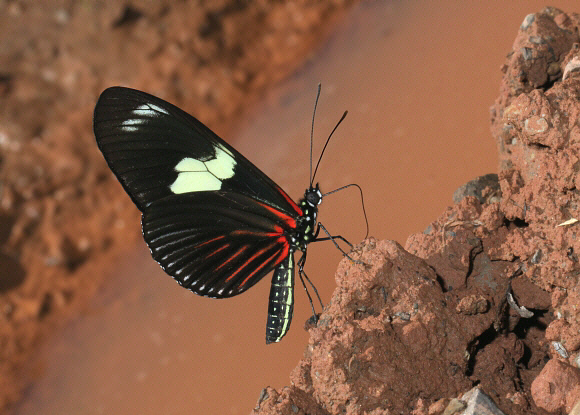![]() Heliconius doris viridis, Tatama NP, Colombia – Adrian Hoskins
Heliconius doris viridis, Tatama NP, Colombia – Adrian Hoskins
Introduction
The tribe Heliconiini, colloquially known as Longwings, includes 71 species, all confined exclusively to the neotropics. The Heliconiini includes the genera Heliconius, Podotricha, Dryas, Agraulis, Dione, Dryadula, Eueides, Neruda, Laparus and Philaethria.
This species is placed in the genus Heliconius by most authorities, but Lamas places it in Laparus.
Heliconius doris exists as 4 named subspecies. In most of these the ground colour is black, and the pattern of cream on the forewings is constant. The exception is obscurus from Colombia in which the forewings are often entirely black. The patch of colour radiating from the base of the hindwings is green in obscurus, but in dives, viridis and doris it can be either blue, red, pink or dark cream.
Heliconius doris is a common and widespread species, found from Mexico to Bolivia.
![]() Heliconius doris dives, Rio Claro, Colombia – Adrian Hoskins
Heliconius doris dives, Rio Claro, Colombia – Adrian Hoskins
Habitats
The butterfly occurs commonly at elevations between 0-1700m. It is usually seen singly or in two’s and three’s, fluttering around flowering bushes in sunlit areas at the forest edge.
Lifecycle
The eggs are yellow, and laid in clusters of up to 200. When fully grown the caterpillar is greenish-yellow with transverse black bands across the back, and branched black spines along the back and sides. The larvae feed gregariously on Passiflora. The pupa is reddish-brown and devoid of spines. Pupation sometimes takes place gregariously on tree trunks.
![]() Heliconius doris obscurus, Medellin, Colombia – Adrian Hoskins
Heliconius doris obscurus, Medellin, Colombia – Adrian Hoskins
Adult behaviour
Like other Heliconiines, doris has a very graceful and persistent flight, beating its wings very slowly as it flutters in search of flowers or larval foodplants.
Males often settle close to streams in dappled sunlight, to imbibe mineralised moisture from rocks, mud or sand. Both sexes fly in open sunlight and visit Lantana flowers for nectar. Females also visit Psiguria and Psychotia flowers for pollen. They process the pollen to extract proteins which enable them to continue producing eggs over a long period. The proteins also increase longevity – adults can live for up to 9 months, much longer than other rainforest species.

Heliconius doris, male, Catarata Bayoz, Le Merced, Peru – Adrian Hoskins
